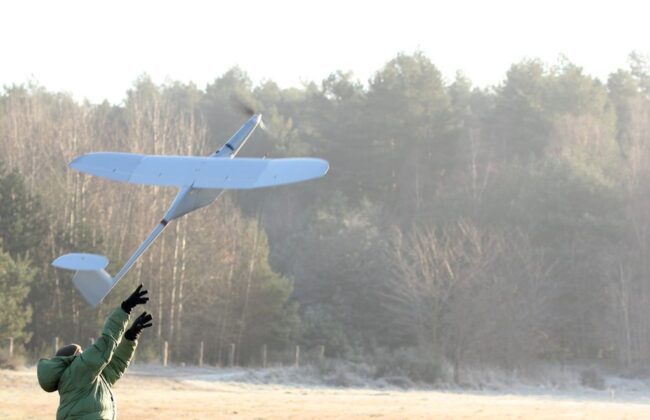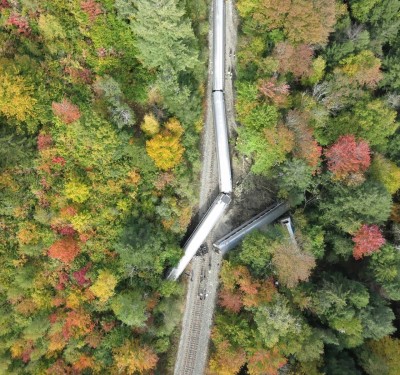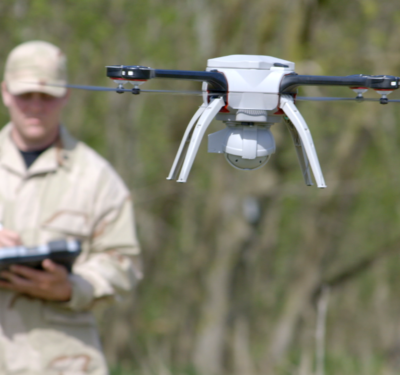
Ukraine’s struggle to repel Russian invasion has been distinguished by its successful adaptation of low-cost drones, military and civilian alike, to support ground forces on the frontline. Those following the conflict have by now seen hundreds videos of drones surveilling enemy forces about to fall under a heavy hammer. But it’s much rarer that we hear what it’s like to pilot those drones.
That’s a perspective I sought in an interview over Zoom with a veteran Ukrainian drone pilot going by the callsign DK, who is serving with the 13th Central Department of the Security Service of Ukraine (SBU).
DK reached out to me on behalf of Army of Drones, a crowdfunding campaign by Ukraine’s United24 platform, seeking to supply Ukrainian troops with drones. By late April, it had raised $108 million, bought 3,300 drones, and received 400 drone donations. Currently the campaign is collecting money to purchase 10 Danish RQ-35 Heidrun drones.
DK today mostly operates the FlyEye drone, built by WB Electronics of Poland.
Sébastien Roblin: How and when did you first start piloting drones?
DK: I started with Armed Forces services seven-eight years ago [during the initial Russian invasions 2014-2015]. I saw real potential in them as my specialty was recon, and UAVs allow reconnaissance in three dimensions, not just what you can see on the ground. It’s a game changer. I was amazed at how effective we became gathering info over territory we didn’t control, giving us opportunities we couldn’t have imaged before.
I used a variety of UAVs then. Mostly FlyEye now because of its effectiveness, it’s a nice product though it still needs some updates. We actively communicate with UAV manufacturers to share our feedback because our experience [using drones in a high-intensity conflict] is in some cases very unique.
The WB Electronics FlyEye is a hand-launched surveillance drone, 20 of which were purchased by Army of Drones last August following a donation by Poland shortly before Russia invaded. FlyEyes are equipped with both infrared and 30x magnification optical cameras in a gyro-stabilized ball turret nested into the fuselage.
Sébastien: What advantage does the FlyEye have compared to the civilian octocopters—particularly Chinese-built Mavic and Matrice—used in such large numbers in Ukraine by both sides?
DK: It’s a different class of drone. Drones likes Mavic support a company or at maximum a battalion. These have an operational radius of around five kilometers while FlyEye gives you radius of 30 up to 80 kilometers [18-50 miles], which means you can patrol more territory.
The tactical level systems help infantry fighting versus infantry, tanks, BMP fighting vehicles. However, the most valuable targets, like surface-to-air missile systems, electronic warfare systems, and headquarters at brigade level and higher are deployed far away from frontline. And systems like FlyEye allow us to find them and deal with them.
A FlyEye can be remotely piloted out to a 31-mile radius using a controller resembling a Nintendo Switch. It can fly farther using relays, or in autonomous mode following waypoints or even chasing a ground convoy. When its mission is done, it parachute-drops its cameras and battery before making a glide landing.
We used FlyEye for months and didn’t lose it!
Sébastien: That’s noteworthy, as I recall a report stating both sides were losing drones on average after just seven day of operational use.
DK: People learned from experience. Those high losses happened because we were unprepared for such a big war. Of course, UAV operators need experience just like tankists. The cool thing about UAVs is when you lose one, you don’t also lose the operator and their experience. And sometimes you’re consciously ready to lose a UAV to accomplish a mission goal with a value much greater than that of the drone beings sacrificed.
To read more of Sébastien Roblin’s reporting on Ukraine, go to the latest issue of Inside Unmanned Systems.
Sébastien: Does it make more sense to distribute drones to frontline ground units, or to have them pooled in specialist independent units?
DK: I would say we should divide usage by layers. In general, a UAV is a camera packed into an aircraft and some radio stations [one on the ground, one built into the UAVs]. Intel, recon should be task for special units who have expertise for doing that.
But for infantry, drones are foremost for situational awareness. A platoon commander with a few drones, even small commercial drones, they have more time to analyze the situation around them and find the right solution. I have friends who fight in infantry whom I give relevant information. They really like that; in some cases, if they didn’t have eyes in the sky things could end tragically for them.
Before we had UAVs, we could only spot incoming assaults coming at us when infantry see them. With FlyEye we can see them move more or less from their starting position. It gives time for our infantry to prepare, commanders time for decision-making, and it ends therefore in a failed assault on our positions. All the things you hear about massive assaults failing at Bakhmut, and Avdiivka? UAVs play an important role in making that happen.
If you talk about [separate] UAV units—they have different roles—some carry electro-optical/infrared cameras, some carry electronic warfare equipment for reconnaissance. Russians too have UAV companies with drones that can carry a mobile system to detect people by their cell phones.
Sébastien: Have you ever seen Russian troops surrender to a drone?
DK: Not personally, except when they’re about to be captured by troops on the ground. But drones play a role as a safe ‘layer’ before surrender, when you see your enemy and he cannot hurt you. Russians are sneaky, sometimes they show you they are surrendering and then violate that, and it ends in our losses. So, UAVs help keep a safe distance [while accepting surrenders].
Sébastien: What counter-measures against drones are proving most effective and/or causing the most losses?
DK: In general, GPS is not working on the frontline. Our systems and Russian electronic warfare systems jam GNSS [Global Navigation Satellite Systems] and other types of radio links UAVs rely on. So, we need drones that remain effective despite that. Not all UAVs can [for example, some civilian drones automatically land after losing satellite navigation signals]. But we’ve built some really creative solutions the Russians can’t do anything about which we’ll scale up in the future.
We learned from experience, and we react quickly in response to what Russia is developing. And they adapt to us too. We also have some surprises in store for them—sometimes they’re not ready for them—and we hope they won’t for a while. We’ve succeeded not only on land but also sea—we can see the enemy anywhere, even their most well-protected places.
Sébastien: Could you tell us about a few of your combat experiences with drones?
DK: I’m a UAV crew chief, so I usually look at enemies through a screen at my ground control station. But I’ve also been on the other side of that screen, and experienced shelling by enemy artillery which had its aim corrected by an overflying Orlan-10 drone. Ordinarily, dozens or even hundreds of shells can land randomly with no result. But when there is a bird overlooking you in the sky, the explosions creep closer and closer towards your exact position.
I had an experience when I was holding a position with an infantry platoon and a Russian battalion tactical group [on paper, a unit with 10 times more personnel] was on us with up to 30 vehicles. Our rocket-propelled grenadiers destroyed the first vehicle and the rest spread out. We didn’t even have the necessary weapons to hold this position, but the Russian attack ground to a halt.
Thing is they didn’t have UAVs overhead and we did. So, while we could see our position was vulnerable, they couldn’t.
Sébastien: It’s like playing a card game where you can see what cards the other side has in their hand.
DK: Another story, happened a year ago, the Russians were advancing on Donbas, we found some deep level about 30 kilometers from frontline. Covered by helicopters, and artillery, these two BTGs [battalion tactical groups] were advancing and trying to assault the river. And our artillery and infantry destroyed almost all of them—there were more than 70 vehicles destroyed. Nobody would have known that if there hadn’t been the UAV in the sky.
Sébastien: Are you referring to the notorious failed attempt to cross the Siverskyi-Donets river in May?
DK: Yes, near Bilohorivka! The Russians were doing everything pretty correct. They had UAVs flying overhead, and they calculated we didn’t have enough artillery there [to stop a river crossing.] But thanks to intel gathered in time, our commanders changed plans and defeated their attack.
This attempted pontoon-bridge crossing was one of Russia’s most costly defeats in its summer campaign of 2022, with around 42 armored and over 30 soft-skin vehicles destroyed by a deluge of accurate artillery and awaiting tanks and infantry of Ukraine’s 17th Tank Brigade.
Sébastien: How does FlyEye compare to other drones you’ve used?
DK: FlyEye is NATO certified. To pass certification you need to be really, really reliable. And Ukrainians were the first to implement our feedback as fast as possible. Most drones were built for use in specific missions under certain conditions—say over open deserts where enemy doesn’t have anti-air and electronic warfare systems. New ones need to be developed to guarantee sustainable operations while exposed to enemy disruption.
I was an operator of most Ukrainian UAVs, and American AeroVironment drones like the RQ-11 Raven, RQ-20 Puma and Switchblade-300. I can say FlyEye is a really nice, reliable product by people with military experience who know what drone operators have to expect on the battlefield. But nowadays we’re really fighting more than ordinary warfare. Even good solutions, they still need development.
I was fighting before with all-Soviet equipment, and in general when you take something American it’s three to four times better. But there’s still the need for us to adapt it for conditions here. In most manuals they say, do not fly in conditions of electronic warfare. If we followed that rule, we couldn’t fly our drones anywhere in Ukraine!
In general, I see that most of Western drones were built to fight against terrorists. But the Taliban doesn’t have electronic warfare systems [unlike Russia]. I’ve told American colleagues we are fighting a different kind of a war. In a trench, it doesn’t matter what kind of tech you have when artillery shells are falling on you and enemy has more advanced planes. When Russia invaded us, our UAVs had to work under the conditions of their radio-electronic interference [jamming], while Russian UAVs were prepared to work despite jamming of satellite-navigation signals. The Russians, they can implement smart technical solutions!
Sébastien: What adaptations did you make in the field?
DK: In our department, we were one of the first to find a way to stream video from a drone directly to field commanders. It’s nice when you’re flying and see everything—but when decision-makers can see it too, that shortens time needed to make decisions.
We have adapted a lot, we are very good at small drone ops making them fly longer and further, we are good now [too] at operational-tactical level adapting to enemy counter measures and solutions to avoid losing drones.
And Russia, Iran, they’ve adapted Western technology into their own weapons, made them more effective by using satellite-navigation antennas. The Shahed drones—you know the one’s that “aren’t from Iran,” speaking sarcastically—they used as a weapon of terror [to attack population centers]. We use our drones in terms of saving our country first, and to deny the enemy opportunities on the battlefield.
Sébastien: Thank you for taking the time to share your experiences. Any last words you would like to add?
DK: I just want to emphasize again how important the support of international donors through United 24’s Army of Drones initiative has been. UAVs like FlyEye were bought by Army of Drones using these donations.
Here in Ukraine, we have come to use drones effectively in ways that not even their designers expected—everything from commercial drones, mini- and micro-UAVs to small tactical drones. And if you give us strategic UAVs [long-range/endurance types] we will also make maximum use of them.
I want to say: we’re fighting for our homes, for our families. One of my first combat actions happened just a few kilometers away from the house I lived in. When you donate to help Ukraine, your dollars are spent on things that save our lives and those of our families. I’m really thankful for those friends in the U.S. who keep donating to us.
Editor’s Note: An unabridged version of this interview first appeared on Forbes.com.






